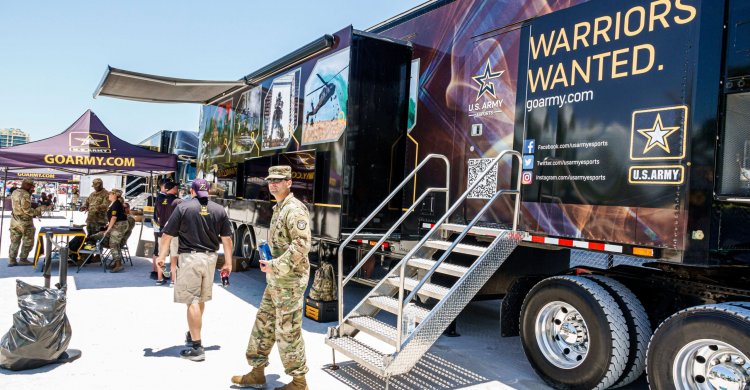Army Is Falling Dangerously Short on Recruitment. Here’s What We Can Do About It.
The Army is falling far short of its 2022 target end strength, the maximum number of personnel permitted by Congress in each military service. A... Read More The post Army Is Falling Dangerously Short on Recruitment. Here’s What We Can Do About It. appeared first on The Daily Signal.

The Army is falling far short of its 2022 target end strength, the maximum number of personnel permitted by Congress in each military service.
A recent news report noted the Army will “fall about 10,000 soldiers short of its planned end strength for this fiscal year,” and has only achieved 50% of its recruiting goal of 60,000 soldiers with only two and a half months left in this fiscal year.
The projected total force for this year is 466,400 soldiers, down from the expected 476,000, and next year it could be as low as 445,000. The Army is already the smallest it has been since 1940, prior to World War II.
This is shaping up to be the worst recruiting year for the Army since the advent of the all-volunteer force in 1973, and it’s not a transitory issue. If the recruiting crisis is not turned around soon, it could seriously affect U.S. national defense long-term—at a time when readiness is crucial.
And it isn’t just the Army. All the other services have reported recruiting challenges and might not make their goals either.
What’s the impact of a recruiting crisis?
When the military services have fewer airmen, special operators, sailors, Marines, and soldiers, they must take what they have and stretch them thinly to cover their requirements. That results in units being deployed too frequently and a shortfall in ready combat units.
This is occurring at a time when American interests are being challenged by a belligerent Russia, an aggressive China, and the perennial threats from Iran and North Korea.
Apart from the idea that a lack of volunteers affects our national security, the other misfortune in this crisis is that young people are missing out on the opportunity to serve their country, to learn leadership, and to grow as citizens. Studies show veterans make better citizens: They volunteer, vote, and serve as community leaders at a greater rate than the general population.
So, what then is causing this recruiting crisis?
The percentage of Americans eligible for service dropped from an already discouraging 29% of Americans to 23%. On top of this bleak statistic, only 9% of Americans, when asked, express a willingness to serve in the military, according to Department of Defense polling data.
The Army is also still recovering from the COVID-19 pandemic. Recruiters could not meet potential recruits face-to-face at fairs, large public events, and after-school programs for two years. At the same time, students who missed in-person schooling are scoring lower on required qualification tests.
Army recruiters are most effective when they have boots on the ground and are active in local communities, which until recently was extremely limited.
To that end, the factor of COVID vaccination requirements have further complicated recruiting in the post-pandemic world. No matter how you feel about it, it’s clear the vaccine requirement is both keeping some young people from volunteering and at the same time causing the military to discharge tens of thousands of otherwise eligible troops.
Furthermore, the labor market has become more competitive as the unemployment rate shrunk to 3.6%, and the private sector has offered suitably competitive compensation and benefits programs. Companies such as Amazon and Starbucks are offering $15 an hour for new employees, making these jobs more appealing for young people.
There are also fewer and fewer veterans every year to inspire military service in the next generation. Moreover, the largely misplaced perception that veterans are not taken care of and struggle with post-traumatic stress disorder and other mental and physical injuries does more to instill fear and caution about military service than inspire the next generation to follow in their footsteps.
The military is often viewed as a “family business” —79% of new recruits have a family member who served. Thus, if you do not have a family member who has served, it’s less likely you will consider service in the military.
In other words, the military has an exposure problem—meaning, fewer and fewer youths are exposed to the military through family members, veterans, or Junior ROTC programs (only 10% of schools have these programs), and we know exposure to military service equals more recruits.
So, what can we do about it?
We need more JROTC programs: 49% of new recruits (who did not have a family member serve) attended a school with a JROTC program even if they did not participate in the program themselves. The more we expose the youth to military service, the more they are interested in service, so the Army should focus on expanding those programs.
The military needs to focus on tailoring competitive compensation and benefit programs to this generation. While Starbucks and Amazon offer cash incentives, military recruiting must offer that, too—and more. Military service opens doors to a variety of careers, travel, and education. To compete with the private sector, recruiting should highlight the opportunities that are unique to military service.
The military also should support after-school sports programs to increase eligibility and address the long-term issue of obesity and poor health in America. Furthermore, the military should resource preparatory programs where recruiters help young people prepare for entrance exams and lose weight, so that those who display a willingness to serve are not limited by physical or academic shortcomings.
American schools can assist in this effort by assuring recruiters have access to students. Military service is a great opportunity for young people in America, and schools could do more to help recruiters meet interested potential volunteers. Many recruiters report, however, that some high schools don’t let them step inside the front door.
Finally, we must foster a culture that values military service and encourages our youth to join the service. This will require the buy-in of coaches, teachers, public servants, and parents to motivate the next generation to selflessly serve their country.
We are in a “war for talent,” according to Army Chief of Staff Gen. James McConville, and we must act accordingly. Our ability to defend our nation in an increasingly unstable world is at stake.
Have an opinion about this article? To sound off, please email letters@DailySignal.com and we’ll consider publishing your edited remarks in our regular “We Hear You” feature. Remember to include the url or headline of the article plus your name and town and/or state.
The post Army Is Falling Dangerously Short on Recruitment. Here’s What We Can Do About It. appeared first on The Daily Signal.




















